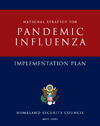
By now, you've probably heard that there is a pandemic
flu plan out there from the federal government. The latest version, which came out in May, is billed as a "strategic, government-wide pandemic flu preparedness and response plan" meaning that the government has inked out (in 233 wordy pages, no less) what it is going to do if a highly infectious type of bird flu makes it to the United States.
But how good is this plan, really? It has its strong points, such as the fact that it recognizes that every person in the United States and all kinds of businesses would be affected (if a pandemic strain of bird flu sickens the nation, schools and workplaces will be closed, and people will be panicked and looking for advice). It also recognizes that we need to get ready now, long before the virus wings its way here via a migrating bird or international airplane.
One area where the federal flu plan is weak, though, is in how it expects us to get ready: The plan relies on people, families and communities to have their own flu plans in place, and assumes everyone will be able to have a closet full of canned goods, bottled water and batteries in case we have to hide out in our homes for a few weeks or months.
Unfortunately, the plan doesn't help communities and people become prepared, it just tells them to be so. Families will need to know what and how many supplies to buy. Hospitals will need more staff. Public safety and emergency services personnel in our communities will need a way to communicate during a crisis.
The reality is that if we are all going to get ready for pandemic bird flu, local and state health departments, community governments and leaders are going to need money to do it. If our communities are left to prepare on their own, using already-stretched resources, will we really be ready for bird flu, or any other infectious disease threats that come our way? Or will we be forced to cross our fingers and hope for the best?
(Think about it: If you turned on your TV news tomorrow and the overly coiffed talking news heads said that people in your city or town were sick from bird flu, would you be ready? Would you know what to do?)
In the end, it all comes down to money. It is up to us now to make sure that Congress provides enough funding so that we can prepare, and it's going to take a lot of dough. The federal plan says we will need $7.1 billion over several years to get ready for bird flu. That's a whopping figure, even to Congress, but we need to get started. To begin, APHA is urging Congress to provide at least $2.3 billion in funding for fiscal year 2007. You can help us get there.
Call, e-mail or write your senators or representatives and tell them we need this funding now to be prepared for pandemic influenza. (Enter your ZIP code and our advocacy tool will provide you with talking points as well as contact information so that you can connect to your members of Congress.
CLICK HERE TO SEND A LETTER)
We need to act now, so that we can get people, families and communities involved in preparing for pandemic flu. We need to give our health workers and hospitals the tools and money they need to be ready, and we need to do it sooner, rather than later. This is your chance to make a difference.
When bird flu hits the United States (and at this point, it is not a matter of
IF, but
WHEN), we will all be a lot better off if we have real, well-funded community-based plans and systems in place, not just a hefty document on some desk in D.C.











